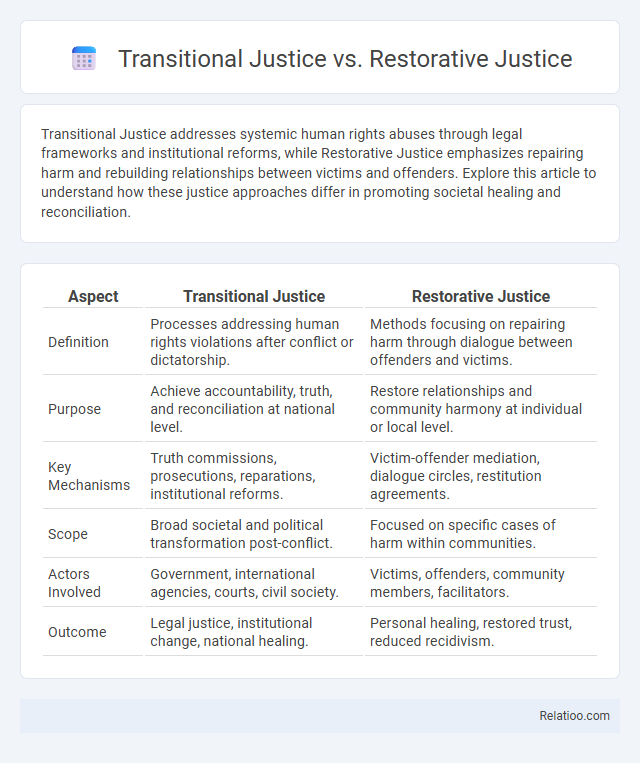Transitional Justice addresses systemic human rights abuses through legal frameworks and institutional reforms, while Restorative Justice emphasizes repairing harm and rebuilding relationships between victims and offenders. Explore this article to understand how these justice approaches differ in promoting societal healing and reconciliation.
Table of Comparison
| Aspect | Transitional Justice | Restorative Justice |
|---|---|---|
| Definition | Processes addressing human rights violations after conflict or dictatorship. | Methods focusing on repairing harm through dialogue between offenders and victims. |
| Purpose | Achieve accountability, truth, and reconciliation at national level. | Restore relationships and community harmony at individual or local level. |
| Key Mechanisms | Truth commissions, prosecutions, reparations, institutional reforms. | Victim-offender mediation, dialogue circles, restitution agreements. |
| Scope | Broad societal and political transformation post-conflict. | Focused on specific cases of harm within communities. |
| Actors Involved | Government, international agencies, courts, civil society. | Victims, offenders, community members, facilitators. |
| Outcome | Legal justice, institutional change, national healing. | Personal healing, restored trust, reduced recidivism. |
Understanding Transitional Justice: Key Principles
Transitional justice centers on addressing legacies of human rights abuses through mechanisms like trials, truth commissions, reparations, and institutional reforms to ensure accountability and prevent recurrence. Key principles include victim-centered approaches, judicial accountability, and promotion of reconciliation to rebuild trust in post-conflict societies. Unlike restorative justice, which prioritizes healing and dialogue between victims and offenders, and reconstruction, focused on rebuilding infrastructure and governance, transitional justice integrates legal and social processes to support comprehensive societal transformation.
Defining Restorative Justice: Core Concepts
Restorative Justice centers on healing harm by fostering dialogue among victims, offenders, and communities, emphasizing accountability and repairing relationships. Unlike Transitional Justice, which addresses systemic human rights violations during political transitions, and Reconstruction that involves rebuilding infrastructure and institutions, restorative justice focuses primarily on personal and communal restoration. Your involvement in restorative justice facilitates empathy, trust-building, and long-term reconciliation within affected communities.
Historical Contexts: When Is Each Model Used?
Transitional justice emerges primarily after periods of mass human rights violations and authoritarian rule, aiming to address legacies of abuse through mechanisms like trials, truth commissions, and reparations. Restorative justice is often applied in contexts focused on community healing and offender accountability, particularly in post-conflict or post-crisis scenarios where rebuilding relationships and social cohesion is paramount. Reconstruction typically follows physical and institutional destruction caused by war or disaster, emphasizing rebuilding infrastructure, governance, and social services to stabilize societies and prevent relapse into conflict.
Goals and Outcomes: Comparing Justice Approaches
Transitional justice aims to address large-scale human rights violations by promoting accountability, truth-telling, and reparations to rebuild societal trust, often following conflict or authoritarian regimes. Restorative justice focuses on healing harm by facilitating dialogue between victims and offenders, seeking reconciliation and community restoration rather than punishment. Reconstruction involves rebuilding political, social, and economic structures to create stable institutions and prevent relapse into conflict, ensuring Your environment supports sustainable peace and development.
Stakeholder Participation in Each Justice Framework
Transitional Justice emphasizes broad stakeholder participation, including victims, perpetrators, and civil society, to ensure accountability and reconciliation in post-conflict societies. Restorative Justice prioritizes direct engagement between victims and offenders, fostering dialogue and mutual understanding to repair harm and rebuild relationships at a community level. Reconstruction focuses on comprehensive participation from governmental bodies, local communities, and international organizations to rebuild infrastructure and institutions, supporting long-term stability and development.
Addressing Victims’ Needs: Contrasts and Similarities
Transitional Justice prioritizes accountability and legal redress to address victims' needs by uncovering truth and delivering justice through trials and reparations, while Restorative Justice emphasizes healing and reconciliation by involving victims, offenders, and communities in dialogue and mutual agreement. Reconstruction focuses on rebuilding physical infrastructure and societal institutions to create a stable environment necessary for long-term recovery, indirectly benefiting victims by restoring basic services and economic opportunities. Your approach to victim support should consider these distinctions to balance legal recognition, emotional healing, and sustainable development effectively.
Accountability Mechanisms: Transitional vs Restorative
Transitional justice employs formal accountability mechanisms such as criminal prosecutions, truth commissions, and reparations to address systemic human rights violations and promote legal redress. Restorative justice prioritizes community-based accountability through dialogue, victim-offender mediation, and reconciliation processes that aim to repair harm and restore relationships. Your understanding of these differing accountability approaches is crucial for selecting effective justice strategies in post-conflict or post-authoritarian contexts.
Truth-Seeking and Reconciliation Processes
Transitional justice prioritizes truth-seeking through formal mechanisms such as tribunals and truth commissions to address past human rights violations and foster reconciliation. Restorative justice centers on repairing harm by facilitating dialogue between victims and offenders, promoting mutual understanding and community healing. Reconstruction involves rebuilding societal institutions and infrastructure, emphasizing reconciliation as a foundation for sustainable peace and justice in post-conflict settings.
Challenges and Criticisms of Both Models
Transitional justice faces challenges such as balancing retributive measures with reconciliation efforts, addressing victims' needs while ensuring accountability, and overcoming political resistance in post-conflict societies. Restorative justice often encounters criticisms related to power imbalances between offenders and victims, the risk of minimizing criminal responsibility, and difficulties in achieving consensus on reparative outcomes. Your understanding of these models can be deepened by recognizing that reconstruction efforts must integrate social, economic, and political dimensions while often struggling with resource limitations and the persistence of structural inequalities.
Integrative Approaches: Can Transitional and Restorative Justice Coexist?
Transitional Justice and Restorative Justice can coexist as integrative approaches by addressing both accountability and healing in post-conflict societies. Transitional Justice mechanisms such as truth commissions and trials focus on legal redress and institutional reform, while Restorative Justice emphasizes victim-offender dialogue and community restoration, creating complementary pathways for reconciliation. Your implementation strategy benefits from combining these methods to ensure holistic recovery and sustainable peace.

Infographic: Transitional Justice vs Restorative Justice
 relatioo.com
relatioo.com